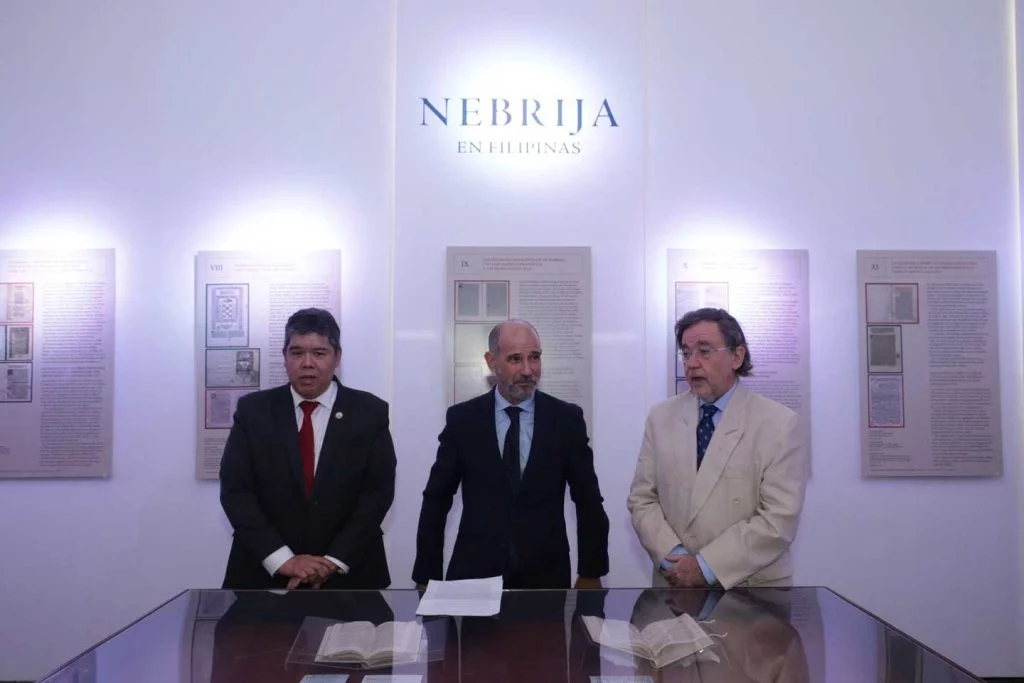MANILA, PHILIPPINES — Not many know that Tagalog actually had its first grammar published before many European languages. The linguistic milestone can be greatly credited to the Spanish grammarian Elio Antonio de Nebrija, who played a pivotal role in that development. On March 12, Instituto Cervantes unveiled at its Intramuros branch the exhibition Nebrija en Filipinas, dedicated to celebrating the cultural contributions of Elio (1444-1522). Nebrija’s impactful legacy extends to languages like Tagalog and Cebuano, with grammars published ahead of many European languages.
Nebrija en Filipinas, tailored for Filipino audiences, is an adaptation of the Nebrija exhibition organized by the National Library of Spain in 2022, commemorating the 500th anniversary of Elio’s death. Through informative panels and displays of books, the exhibition will highlight Nebrija’s cultural contributions and seek to contextualize them within the publication of the first grammars of the Philippine vernacular languages. Elio’s teachings directly shaped these linguistic endeavors.


Elio was a highly reputed scholar during the Renaissance period in Europe. His book Introductiones Latinae, a groundbreaking manual for teaching Latin, not only earned him recognition in Spain but also garnered international fame. He also wrote bilingual dictionaries in Latin-Spanish and a Gramática de la lengua castellana, published in 1492, which is recognized as the first grammar of modern European languages. It became the model for Spanish friars who attempted to analyze the grammar of the New World, both in America and the Philippines. These missionaries, who had learned Latin from Elio’s methods, applied the model, with its theoretical considerations and bilingual translations, in their description of these languages. As a result, Tagalog saw its first grammar book published in 1610 with Francisco Blancas de San José’s Arte y reglas de la lengua tagala. It was followed by similar initiatives with other vernacular languages, among them the Arte de la lengua iloca, composed by the Agustinian Francisco López in 1627, and the Arte de la lengua bisaya de la provincia de Leyte, written by the jesuist Domingo Ezguerra in 1663.
Proud, intelligent, and audacious, Elio was a stalwart fighter for pure Latin and always wanted to go down in posterity with the nickname grammaticus (grammarian). When he presented a preview of what would later become his Grammar of the Castilian Language to Queen Isabel la Católica, the sovereign was initially surprised, unable to grasp the utility of a treatise teaching the rules of a language acquired naturally. However, Elio successfully persuaded her that languages benefit from both descriptive and normative grammars to prevent them from running amok. The paradoxes of fate have made his Castilian grammar his most renowned work today. Nevertheless, Elio deserves to be remembered for many other reasons.





For Elio, the revival of Latin was an incentive for other scholarly pursuits. The voyages of the discoverers aroused his curiosity, leading to a fascination with cosmography and a desire to learn about developments from across the Atlantic. In these and other scholarly ventures, Elio revealed himself as a full-fledged humanist.
Even after his death, Elio’s fame did not diminish. His grammars and lexicons were published in Spain and gained recognition in France, Italy, Germany, and the Netherlands. The Latin manual he had written for his students in Salamanca attained exclusive authorization for teaching the discipline, a decree made by King Philip III in 1598. Elio’s Latin grammar manual continued to be esteemed, annotated, and adapted based on location and circumstances until the 19th century.


The exhibit Nebrija en Filipinas, which will run until June 12, is organized by Instituto Cervantes in collaboration with Fundación Antonio Nebrija (Madrid), the Embassy of Spain and AECID, Biblioteca Nacional de España, and the University of Sto. Tomas (Manila). Nebrija en Filipinas is an adaptation of the original exhibit Nebrija, curated by Dr. Teresa Jiménez Calvente, with the addition of panels focused on the Philippines composed by Marlon James Sales of UP Diliman. The exhibit will have a second leg in the Miguel Benavides Library of UST from August to October.










